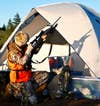Adirondack Road Trip: The Whitetail Empire
Looking for solitude, adventure, and a mature public-land buck? Then New York’s vast Adirondack Park is the place to go....

Looking for solitude, adventure, and a mature public-land buck? Then New York’s vast Adirondack Park is the place to go.
Days Required: Three to four. Necessary Paperwork: Big-game license ($140 for nonresidents; www.dec.ny.gov); muzzleloader license ($140); bear tag ($25); free backcountry permits are required if you stay in one place for more than three days. Must-Have Gear: Backcountry bucks can be very receptive to calling. Bring grunt, rattling, and snort calls. Before You Go: Order a guidebook and map of the area you intend to hunt (adk.org), then make a wet run with your camping gear. Repair or replace anything that fails, and ditch equipment you don’t use. Last-Resort Guide: Adirondack Foothills Guide Service.

Photos by Tom Fowlks
The park features more than a dozen wilderness areas that cover about 1 million acres–nearly 180,000 of which are a butt-kicking 3 miles (or more) from the nearest road as the raven flies. Even in a region known for its backwoods deer hunters, the Adirondack’s plentiful way-back country offers an excellent opportunity to go one-on-one with whitetails that often die of old age.
|| |—| | Map by RADIO| To hunt these deer, however, you have to bring camp to them. That means backpacking or paddling your gear into remote and often rugged terrain for a multiday stay. An extensive network of hiking trails helps, but the hunting is still a challenge. Windfalls, ledges, beaver flows, and gorges make traveling off-trail tough, and long, snowy winters keep deer densities low. At times it can seem like you’re searching for a needle in a primeval haystack of towering white pines, hemlocks, and ancient birches. Yet the deer are there, and the rewards can be great.
The last several years, I’ve teamed up with a veteran hiker turned hardcore hunter for backpack hunts in the park. I can count the number of deer I saw on our best trip on one hand, but I’ve never seen another hunter and a remarkable percentage of the deer I do see are rack bucks. Only once have we been skunked.

We scour maps for areas that have lots of terrain features in the form of summits and ridges, and which are too far in to be frequented by day hunters. Mature Adirondack bucks like to travel and bed high, and they often make their scrapes and rub lines on knobs and other high spots. Hiking ridgelines makes finding pockets of buck activity easier, and points and saddles create natural funnels if you prefer sitting over still-hunting or tracking.
Good areas to prospect include all of the park’s larger wilderness areas. Among these are the West Canada Lake, Silver Lake, and Siamese Ponds wildernesses in the southern Adirondacks, each of which covers more than 100,000 acres. Canoe routes in the Five Ponds Wilderness in the western Adirondacks let you paddle your way in. The 193,000-acre High Peaks Wilderness in the eastern Adirondacks offers the most way-back country and the greatest challenge in terms of rugged terrain and low deer densities. It also produced my best Adirondack buck.

When to go is a matter of preference. I like the first week of November. Overnight lows are still bearable; whitetails can be found feeding on beechnuts and acorns (on south-facing slopes, primarily in the southern Adirondacks); and most important, the pre-rut has bucks cruising for does.

Camping is permitted at designated sites on water bodies and anywhere that’s at least 150 feet from a pond or stream. The region’s many lean-tos can eliminate the need for packing in a tent, but we avoid them because they’re magnets for gnawing critters, including bears.
Come prepared to get your game out. The drags can be very long, and although sleds and carts can help you do the job, quartering and packing your whitetail out is sometimes the only practical solution.